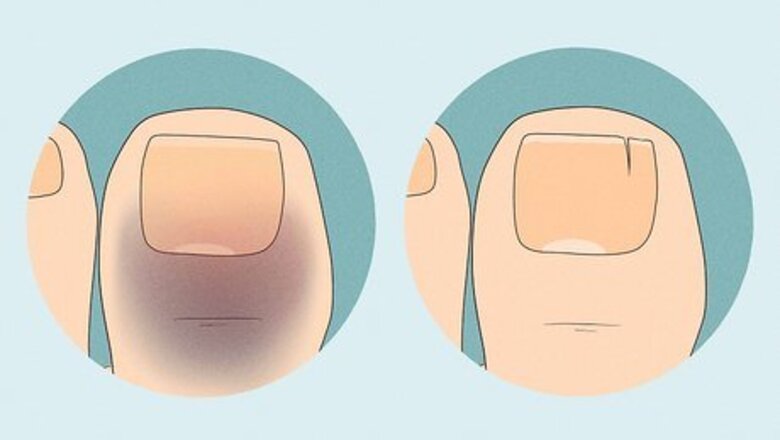
views
X
Research source
Basic Stubbed Toe Treatments

Check the condition of the toe immediately after the injury. The first step to treating a stubbed toe is to see how bad the damage is. Carefully and gently remove the shoe and sock on the injured foot. Examine the injured toe, taking care not to injure it further by handling it roughly (a friend can help here). Look for the following signs: A "bent" or "misaligned" appearance Bleeding A broken or misplaced nail Bruising Heavy swelling and/or discoloration Depending on which (if any) of the above signs you see, the treatment for your toe can differ. See below for specific suggestions. If it is too painful to remove your shoe and sock, you probably have a fracture or sprain in your toe and/or foot. This is not a dangerous condition, but you should still see a doctor to receive treatment.

Clean and disinfect any abrasions or cuts. If you notice any spots on the toe where the skin has been broken, you will want to clean them promptly to avoid infection. This includes cuts, scrapes, abrasions, and breaks in the nail. Carefully wash the toe with soap and warm water. Dry the toe gently with a clean cloth or paper towel, then rub a little anti-bacterial cream onto any breaks in the skin. Protect the toe with a clean bandage. Replace the bandage every day as the toe heals. See How to Clean a Wound for step-by-step information.

Apply ice to reduce swelling. Most stubbed toes will be followed by at least a little painful swelling. This can make the toe awkward, unwieldy, and even more vulnerable to pain. Luckily, it's easy to reduce the swelling with a cold compress. There are many ways to do this — for instance, you can use a gel ice pack, a bag of ice or even an unopened bag of frozen vegetables. Whatever you use for your cold compress, wrap it in a towel or rag before pressing it into the skin. NEVER put your ice pack directly on your skin. Direct, prolonged ice-on-skin contact can further damage the skin, making your injury worse. For the first 24 hours after you stub your toe, you should ice it for 20 minutes every waking hour. After that, you’ll only need to ice it two to three times a day until the pain subsides. See our article on cold compresses for more detailed information.

Avoid putting pressure on the toe. Even mundane, day-to-day activities can be painful when you're walking on a stubbed toe. To reduce further pain and swelling, try to shift some of your weight to your heel as you walk and stand. This can be a difficult balance to strike, as putting all of your weight on your heel can make walking awkward and cause soreness over time. Try to take just enough pressure off of your toe to avoid pain when walking. Once the swelling has subsided in your injured toe, light cushioning (for instance, a gel insole) can help minimize pain from walking. If the pain in your toe doesn't subside after an hour or two, you may want to take a break from physical activities like sports, etc. for a few days until you no longer feel pain. Additionally, keeping it elevated with a pillow while laying down can help reduce both pain and swelling.
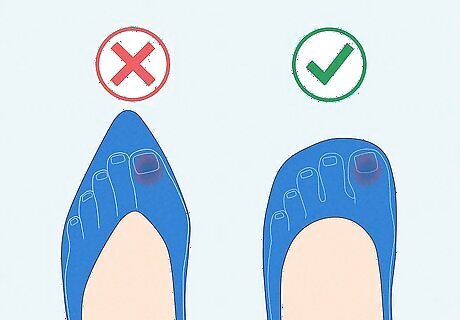
Make sure your shoe has enough space for the toe. Tight shoes can make a painful, swollen toe even more irritated. If you can, wear a loose, comfortable pair of shoes after your injury to protect the toe from more pressure. If you don't have a replacement pair of shoes available, you can try loosening the laces. Open-toed shoes like sandals and flip-flops can be the best choices of all — not only do they put no pressure on the top and sides of the toe, but they also allow easy access for cold compresses, bandage changes, and so on.

Treat lingering pain with over-the-counter medications. If the pain from the stubbed toe doesn't subside on its own, over-the-counter (OTC) painkillers can be a good temporary solution. Here, you have many choices. Acetaminophen (paracetamol) and non-steroidal anti-inflammatory drugs (NSAIDs) like ibuprofen (Advil, Motrin) or naproxen (Aleve, Naprosyn) are both available in many varieties from nearly any grocery store or pharmacy. Be sure to follow any and all dosage instructions on the medicine's packaging. Even (OTC) medicines can have dangerous side effects when taken in large doses. Do not give aspirin to children.
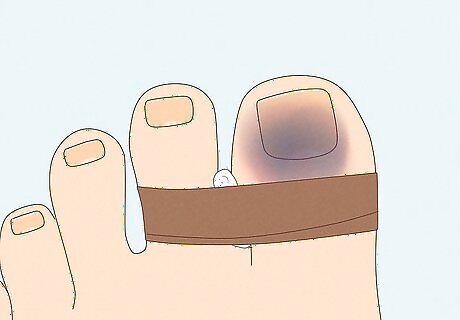
Support your toe by buddy taping. Wrap tape around your stubbed toe and the toe next to it to give it a “buddy” for support. You can place a small piece of cotton in between your toes to prevent the area from becoming too moist. Change the cotton daily.

Elevate especially bad toes. Another great way to reduce swelling is to elevate the injured toe above the body when you are sitting or resting. For instance, you might try propping it up on a stack of pillows when you lay down. Putting a swollen injury above the rest of your body makes it more difficult for the heart to pump blood to it. This causes blood to gradually flow out of the swollen area, reducing swelling. While it's basically impossible to do this while standing and walking, it's smart to take the time to elevate your injured toe whenever you plan on sitting or laying down for a long time.
Recognizing Serious Problems
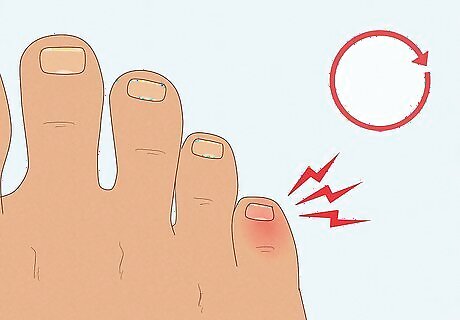
Be wary of lingering pain and inflammation. As noted in the introduction, most stubbed toes are not serious injuries. Thus, a good indication that your stubbed toe is something more serious is if it does not seem to get better right away. Pain that doesn't get better in the same amount of time as an ordinary bruise is often a sign of an underlying problem that requires special treatment. Specifically, be on the lookout for the following signs: Pain that doesn't lessen within an hour or two Pain that fully returns whenever pressure is put on the toe Swelling and/or inflammation that makes it difficult to walk or wear shoes for a few days Bruise-like discoloration that doesn't go away within a few days

Look for signs of fracture. Especially-bad stubbed toes often result in a fracture (a break in the toe's bone). In this case, it's usually necessary to receive an X-ray, cast, or foot brace. Signs of a fracture include: An audible "crack" or "pop" at the time of injury A toe that visually appears "bent," "kinked," or "crooked" Being unable to move the injured toe Prolonged pain, inflammation and bruising. Note that many broken toes don't prevent the injured person from walking. Being able to walk isn't a sign that a toe isn't broken.
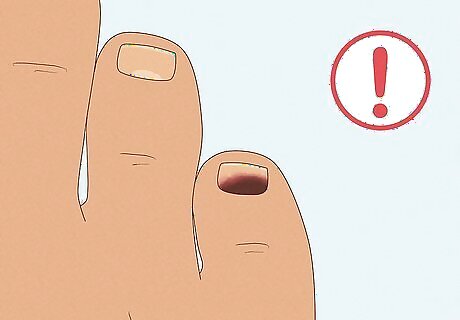
Look for signs of subungual hematoma (blood under the nail). Another injury that's common from a stubbed toe is for blood to gather under the toenail. The pressure between the built-up blood and the nail can lead to prolonged inflammation and swelling, making recovery a long, uncomfortable process. In this case, a doctor can make a small hole in the nail, allowing the blood to drain and relieving the pressure. This procedure is called a trephination.
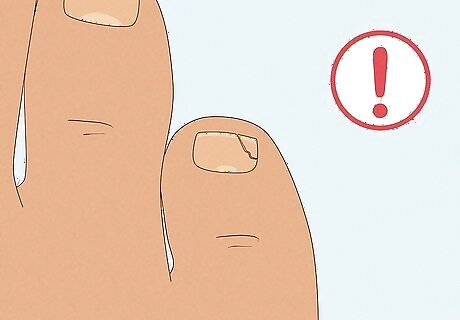
Check for breaks in the nail. A toe injury that causes part or all of the nail to detach from the nail bed can be extremely painful. While treatment at home may be possible in some cases, seeing a doctor will give you access to treatments for reducing pain, protecting the wound, and fighting infection that may not be available to you otherwise. In addition, if an injury is serious enough to break your nail, it is possible that it has also caused a fracture or another problem that requires a doctor's help.
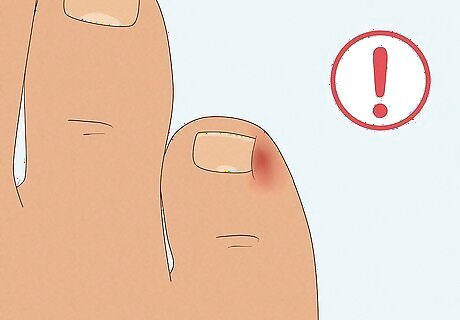
Watch for signs of infection. You can usually heal a stubbed toe at home just fine, but you should always be on the lookout for signs of infection. If you notice increased pain, redness, swelling, numbness, tingling, or a fever, see your medical provider as soon as possible.

If the toe injury appears serious, see a doctor. All of the problems mentioned above — toe fractures, hematomas, and nail breakages — are good reasons to see a doctor. A medical professional can use X-ray machines and other equipment to accurately diagnose your problem. In addition, doctors and nurses have the training necessary to instruct you how to protect your toe as it heals. Again, it's important to remember that most stubbed toes won't require medical attention. However, if you have reason to believe that yours is serious, don't be afraid to make an appointment. Always follow your doctor's advice over advice you find online. If anything your doctor tells you contradicts something you've read in this article, listen to your doctor.













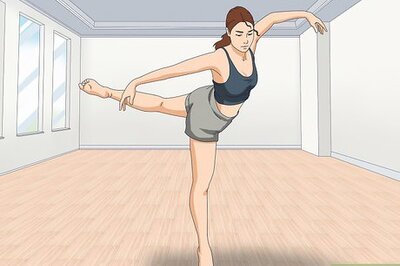
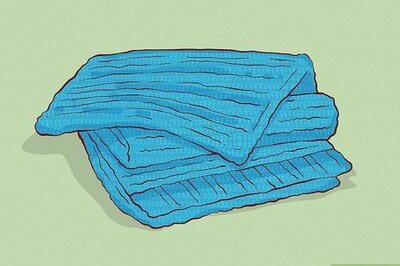




Comments
0 comment